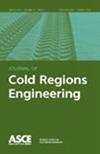Prevention of Water Intake Blockage by Ice during Supercooling Events
IF 2.3
4区 工程技术
Q3 ENGINEERING, CIVIL
引用次数: 5
Abstract
Blockage of water intakes by underwater ice formation during supercooling events is a widespread and common problem in northern regions during winter. In this context, underwater ice formation means deposition of frazil ice and growth of platelet ice. Blockage happens when underwater ice forms on the structural components of the intakes, particularly the intake trash racks, decreasing the area of the intake available for flow. This article evaluates potential solutions for preventing blockage. The solutions are collected into four broad categories: avoidance, prevention, mitigation, and remediation. Avoidance locates the intake so that it is never exposed to supercooled water. Avoidance is not possible in rivers and streams and requires depths in lakes and reservoirs that are not reachable for most intakes. Prevention stops supercooled water from entering the intake. The use of heat to warm the intake flow so that it is not supercooled is the most reliable way of preventing intake blockage by underwater ice. The formation of stable ice covers is a reliable means of preventing blockage events but cannot entirely eliminate them. Mitigation modifies the intake, or its operation, to prevent blockage. Ice adhesion to trash rack bars can be reliably prevented by maintaining the bar surface at a temperature greater than 0°C. Other approaches to mitigation including reducing intake flow, modifying the trash rack design, using coatings or alternative materials, or insulating portions of trash rack bars are not reliable for preventing blockage. Remediation actively removes underwater ice from the intake components while the intake is in operation. Mechanical or manual raking of the intake trash racks to remove deposited frazil ice can be a reliable means of preventing blockage. In addition, a strategy, management, addresses intake operation when practical measures for blockage prevention are not available. Management accommodates periodic blockages into the operation of facilities through detection, damage prevention, and quick and efficient restarts.防止在过冷事件中被冰堵塞进水
在过冷事件中,水下结冰阻塞取水口是北方地区冬季普遍存在的问题。在这种情况下,水下冰的形成意味着薄冰的沉积和血小板冰的生长。当水下冰在进气道的结构部件上形成时,特别是进气道的垃圾架上,就会发生堵塞,减少了进气道的可用流动面积。本文评估了防止堵塞的潜在解决方案。解决方案可分为四大类:避免、预防、缓解和补救。避免定位进气口,使其永远不会暴露在过冷水中。在河流和小溪中是不可能避免的,需要在大多数取水口无法到达的湖泊和水库的深处。防止过冷水进入进气口。利用热量加热进气流,使其不过冷,是防止水下冰堵塞进气的最可靠的方法。稳定冰盖的形成是防止阻塞事件的可靠手段,但不能完全消除阻塞事件。缓解措施修改进气或其操作,以防止堵塞。通过将垃圾架棒的表面温度保持在0°C以上,可以可靠地防止冰粘附到垃圾架棒上。其他缓解方法,包括减少进气流量、修改垃圾架设计、使用涂层或替代材料,或对垃圾架杆的部分进行绝缘,都不能可靠地防止堵塞。当进水口运行时,补救措施会主动清除进水口组件中的水下冰。机械或手动耙取进气垃圾架,以清除沉积的冷冻冰,是防止堵塞的可靠方法。此外,当没有实际的堵塞预防措施时,策略,管理,处理进气操作。管理人员通过检测、预防损坏和快速有效的重启,将定期阻塞纳入设施的运行中。
本文章由计算机程序翻译,如有差异,请以英文原文为准。
求助全文
约1分钟内获得全文
求助全文
来源期刊

Journal of Cold Regions Engineering
工程技术-地球科学综合
CiteScore
3.20
自引率
5.00%
发文量
23
审稿时长
>12 weeks
期刊介绍:
The Journal of Cold Regions Engineering publishes practice- and research-oriented articles from any area of civil engineering that is substantially related to cold regions. Topics include ice engineering, ice force, construction on permafrost and seasonal frost, cold weather construction, environmental quality and engineering in cold regions, snow and ice control, cold regions materials, and surveying and planning in cold regions.
 求助内容:
求助内容: 应助结果提醒方式:
应助结果提醒方式:


